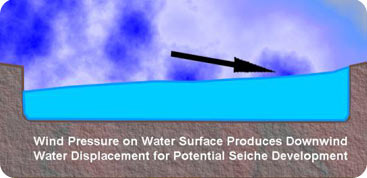If you rock back and forth in a full bathtub, the water sloshes from one end of the tub to the other. The depth of the water drops at one end, but increases at the other. This “rocking” motion is a special kind of wave -- a seiche -- from a French word that means “to sway back and forth.”
 Credit: Keith C. Heidorn, PhD, The Weather Doctor, http://www.islandnet.com/~see/weather/doctor.htm
Credit: Keith C. Heidorn, PhD, The Weather Doctor, http://www.islandnet.com/~see/weather/doctor.htmSeiches form in nature, too -- most commonly in lakes, but also in seas and bays -- any fairly compact body of water that has a “rim” of land around it.
A seiche forms when something disturbs the water level, causing one end to rise or fall. The disturbance can come from an earthquake, a storm, or some other source. Storms, for example, have lower air pressure than the atmosphere around them. When a storm passes over one part of a sea or other body of water, the higher air pressure away from the storm mashes down the water. That lowers the surface level and pushes water toward the end with low pressure.
But gravity tries to equalize the water level. As it pulls, it creates a seiche -- a wave that rocks up and down, with its speed determined by the water’s depth.
Most of the time, a seiche is no more than a few inches tall. Sometimes, though, the wave can be large enough to break ships away from their moorings, or even slosh out of its basin and cause flooding -- sometimes with deadly results. A seiche associated with a tsunami that hit Hawaii in the 1940s, for example, boosted the tsunami’s magnitude, killing dozens of people -- destruction from a sloshing wave.

